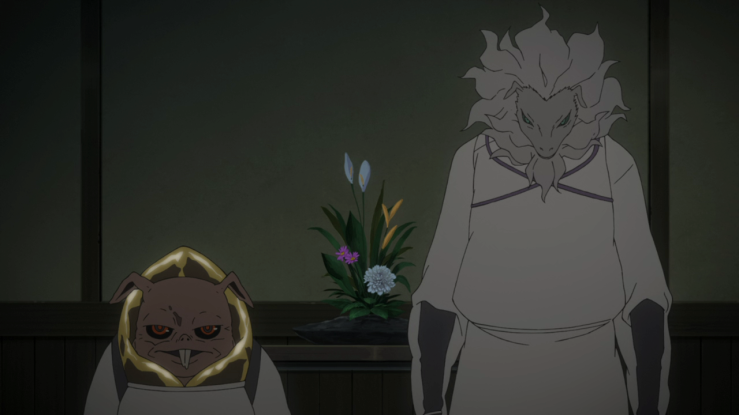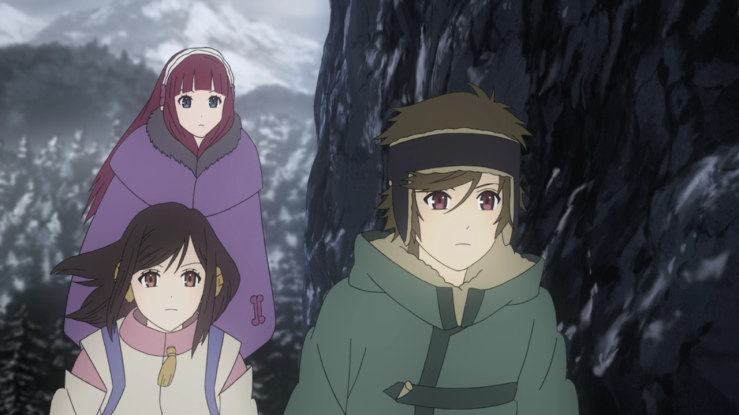[WARNING: SPOILERS]
Shinsekai Yori is that rare thing, an anime adaptation of a novel—not a light novel, but a novel, a capital-N novel—and it shows. The plot unfolds gradually and deliberately, free from the limits of episodic stories that reliably return their characters to the status quo. Indeed, characters age and develop over the course of years; romances, families, and individuals rise and fall. Its scope is panoramic: it creates a complete picture of an alternate world centuries into the future and a small community living there, allowing the writing’s focus to transgress from the psychological lives of the characters into disquieting political allegory while remaining thematically congruent. At the centre of these themes is the question of appearance vs. reality, truth vs. mystery. Are there truths that should not be known to the world? Can the things we love be used to control us and conceal the truth; and is it sometimes better to keep it that way? Up until the end, there are unresolved questions about the strange idyllic world of Kamisu 66, the rural town that is the fulcrum of the story, and it is unclear whether such questions should be resolved when their answers have such devastating consequences.
Shinsekai Yori is named for Dvorak’s popular symphony of the same name; it is interesting to note that the ‘From the New World’ symphony and its iconic melody in the second movement were originally meant to evoke the mystery and promise of a very different New World: America, at a time when the predominant European attitude towards the United States had not fomented into disappointment and resentment. In a similar way, the wonder of the Japanese pastoral in the early episodes—the harmonious, isolated world of magic and mystery—steadily declines over the course of Shinsekai Yori. When the melody is reprised in the last arc of the show, it summons not mystery and potential but loss: the loss of innocence, the loss of moral certainty, and loss of that new world where great things were possible. New World becomes Old World, with all its vices.
The show principally follows the lives of five characters who grow up in Kamisu 66 and belong to the same class group at school, where they learn to control and command the psychokinetic powers that led to their world’s state of technological regression. After an encounter with a sentient library robot from humanity’s past, the twelve-year-old characters are exposed to the first of several revelations about their world that continue throughout the show and dramatically affect all five of them personally and psychologically. These revelations focus on the horror and transformation that human societies underwent after the appearance of psychokinetic humans who could kill with a thought; but rather than emphasise merely the nature of these powers as a lesser show might, Shinsekai Yori uses these developments symbolically and allegorically to comment on human psychology and social organisation. There is also something unmistakably Japanese about it; the extreme accommodations necessitated by these psychokinetic humans, or ‘PKs’, including genetic modifications that prevent them from killing other people, smell something like Tokugawa era enforcements of isolation and harmony. Japan in the days of sakoku was the only country to successfully rid itself entirely of firearms; we are wont to criticise this kind of self-imposed isolation, but when the alternative suggested by Shinsekai Yori is a nightmarish chaos in which indolent despots mass-murder powerless commoners, it raises the uncomfortable notion that such enforcements may sometimes be not only necessary but good.
This unhappy impression is compounded by the psychological effects that these revelations have upon the five children, which have far-reaching ramifications in the tiny community of Kamisu 66. There is a consistent suggestion of an aristocratic ethos in the show: that good personal character is the only factor that plays a part in whether one is worthy of power and forbidden knowledge. Saki, the main character, is singled out as possessing unique mental strength, while Mamoru, a gentle-hearted boy who spends his time drawing pictures of his unrequited crush Maria, is unable to emotionally handle the unpleasant realities to which he is exposed. This ends in disaster when he becomes a target for the Board of Education and runs away from home. Maria, following him into the snowy wilderness, bears his child, a birth whose consequences are ruinous in the final arc of the show, when the baby returns as a Fiend—a PK who is able to overcome their genetic programming and use their powers against humans. Similarly, Saki’s friend and crush Shun, a kind and intelligent boy expected to excel, is overcome by his own powers, which leak destructively into the world. The nature of this disorder is, in a none-too-subtle metaphor, described as rooted in the subconscious mind.
It undersells Shinsekai Yori to describe its setting as a dystopia, although it bears a particular resemblance to the sedated society of Brave New World, where drugs and sex are used as a means of political control. The things we love blind us: the library robot explains how the social engineers of their community encouraged young people to relieve stress and tension through sex, heterosexual and homosexual, like bonobos, so they ignore the mysteries of their condition. Characteristically, the only one to resist this is the mentally strong Saki: we’re not monkeys, she says. At that early point of the story, there is still an idealism that resonates in her words. If the Kamisu 66 Ethics Committee and Board of Education represent the enforcers of harmony and a Tokugawa-style consensus, Saki seems initially like a Western transplant, a humanist or Christian seeking truth; cynicism sets in later as she is groomed by Tomiko, the head of the Ethics Committee, to become the next leader of the community and guard the hidden knowledge that undergirds their society.
Indeed, the position of the humanist is occupied by a very different character in the last arc of Shinsekai Yori. Early in the show, when the twelve-year-old children are seeking to escape discovery after speaking to the library robot, they encounter two members of a genetically engineered slave race called Monster Rats (bakenezumi) who help them to evade capture. The first, Squealer, is a sweaty and dishonest groveller whose supplicating attitude to humans belies an apparently self-interested core. The other is Kiroumaru, a strong but gentle retainer who shows a loyalty and kindness to the children that reads as more genuine. These two become central figures as the characters age into adulthood. Squealer turns against the monarch of his colony, overthrows her in revolution, and encourages other rats to do the same in their own colonies—that he would eventually rebel against his human masters also is a predictable development, and the show’s final conflict focuses on this attempt by Squealer to seek, in his view, liberation for his people. Kiroumaru assists the humans in their struggle to repress the rebels.

The injustice of the rats’ condition is not underplayed. The last secret unearthed in the show is that this race of slaves is not the result of genetic experimentation on naked mole rats, as initially believed, but human beings, modified to appear like rats so that they could be killed by other humans; they are the descendants of the commoners who escaped mass-murder by the PKs. Yet, as we see the contrast of the underhanded Squealer and the dignified Kiroumaru, the text does not make much effort to justify the former’s efforts until its conclusion, when he stands defiantly on trial against a panel of PKs who mock his humanist declaration. ‘We are human!’ he cries; and is promptly sentenced to an eternity of physical and mental torture, kept alive as a bundle of nerves and slime. As for Kiroumaru, he admits to Saki that he too had republican fantasies once, but abandoned them and instead sought to do the best he could to improve himself within the system. This cynicism is unexpected in popular media: to accept iniquity as a natural condition and endure its travails is not a comforting moral imperative, especially to Western humanists.

In the final moments of Shinsekai Yori, we see Saki and her partner Satoru raising children in their thirties. They are the only two remaining of the five schoolmates who encountered the library robot. Together with their progeny, they express hope for a kinder world; but this is not Squealer’s hope for universal justice or a transformation of society. Their only expectation appears to be for personal justice, for the secret truths and mysteries of their society to be guarded not with jealousy or paranoia but rather good will and charity. In perhaps the show’s most subtly dark moment, Squealer is extralegally granted the release of death by Saki; his truth will go unspoken and unknown to the world, but Saki decides that she still bears a responsibility to that truth. In the end, therefore, the virtue of truth is only apparent to the ones equipped to handle its implications. No, this is no New World; it is the Old World, with all its vices.


